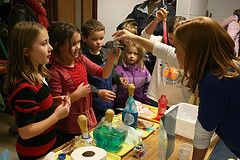Parenting
5 Techniques for Champion Parenting
What can parents learn from teachers who are masters of their craft?
Posted March 26, 2013

A seventh grade Social Studies class in an inner city middle school gets ready for a ninety minute block of learning. The twenty-something teacher stands in the front of the room to start the lesson and he pulls out his phone. He remarks that it’s time for the Wednesday Power Up and scrolls through the downloaded music on his phone. The teacher plays twenty seconds of a song as hands raise enthusiastically in the air. All hands are raised, all students are engaged. One student guesses the song and he moves on to another one. The class is in an uproar, but in a good way. They are joyful.
I coach public school teachers in the Greater New Orleans area. There is name for what I observed in this teacher’s classroom: Joy Factor (J factor) and Tight Transitions. Techniques like these are extracted from the one of the bibles of the Education Reform movement, Teach Like a Champion. The author, Doug Lemov is described as the John Madden of professional teaching. As a young teacher he had a hunch that champion teachers use specific strategies to maximize instructional time and build a culture of high expectations, so he spent several years observing excellent instruction and he now shares it with teachers around the country in books, trainings and videos. His book is a compilation of 49 techniques that enable teachers to close the achievement gap.
What if the techniques used by champion teachers can also help people become champion parents? Think about the times when you are in the grocery store, the playground or a social event and you see a parent nail it and interact with their child with an enviable finesse and savvyness. Is it possible to learn those moves? I'd like to think so. Here are five techniques pulled from my work in the education reform movement that help parents become masters of their craft:
1. Align your team. The most effective leadership teams I’ve observed within schools have a clear mission and purpose, core beliefs or values that are the expression of this mission, and structures or systems that reinforce the overall mission of the team. Do you have a family mission statement? What values are most important in your family and what artifacts exist to support the integration of these values into your daily life?
2. Look for trends and patterns- One of the hallmark moves of the education reform movement is the focus on data driven instruction. Teachers and administrators spend countless hours poring over data, looking for root cause and holes in instruction. Parents should do the same. Make observations about your behavior and your child’s behavior. Use a behavior chart to track the tricky moments, like temper tantrums, disobedience, whining or biting. Make note of the environment, the time of day, your mood, eating patterns, sleeping patterns and frequency of behavior. Then analyze the data. Look for patterns to the behavior and formulate a new plan.

3. Joy factor- One KIPP classroom that I visited in Washington D.C. was filled with the J factor. The kindergarteners were wrapping up a lesson with the teacher when she turned on the Smart Board and found a Just Dance clip of One Direction on You Tube. For five minutes the children were dancing and singing on the rug, laughing, smiling and having fun. Find joy in the work of parenting. Use games, drama, song, dance, humor or suspense and surprise to be playful with your children. Doing so will activate positive emotions and replenish your resilience reserves.
4. Threshold Rule – Doug Lemov writes that the first minute when students cross the threshold into the classroom you must remind them of the expectations. In a classroom, this would look like a teacher standing at the door, greeting each student by name and sharing an uplifting message. As a parent, the thresholds happen anytime you say hello or goodbye to your children or partner. Getting up in the morning, going to bed, picking up and dropping off at school, coming home from work. What do your loved ones see or hear during those times of transition? How do you say goodnight? How do you greet your children in the morning? How do you greet your partner at the end of the day?

5. Practice Perfect- In his new book, Practice Perfect: 42 Rules for Getting Better at Getting Better, Doug Lemov normalizes the idea of practice and discusses effective ways to practice and get better at a craft. Practice often, practice with a partner, try out different techniques, allow yourself to be a cautious observer, accept feedback openly and grow, learn and try again. This is true for parents too. In coaching parents, I ask them to role play or rehearse a new time-out routine or a start-stop routine for giving directions. I give feedback, they adjust, and they try again. I model effective praise and ask them to practice as well. Is there something specific you are working on as a parent, such as a more loving tone, not yelling as much or being more firm with directions? Ask your partner to observe specific interactions with your child and ask for feedback about what you did well and what you should do differently.
The achievement gap is just one hole in the social fabric of our country. The parenting gap is another. Without social support, resources, and information on effective parenting, many parents become frustrated, overwhelmed or disengaged with parenting altogether. There is much that parents can learn from the world of teaching, especially given the shared goal of raising children to be emotionally and socially competent, confident and resilient. Techniques like the ones listed above leave everyone feeling like a winner.


